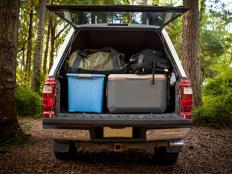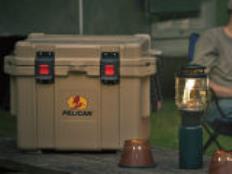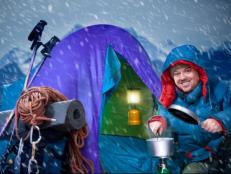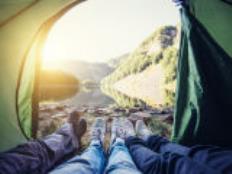
The weather is harsher and the daylight hours shorter, but winter camping has rewards that you just can't get any other time of year. With some extra gear and preparation you can enjoy the beauty and solitude that comes with camping in the snow.
Follow these safety guidelines when planning your trip.
1) Don't go alone. As alluring as the empty wilderness might sound, nature is unforgiving. That's why you should always share the adventure with a camping buddy or two, preferably people who have an assortment of winter skills such as navigating through snow, finding routes, and making shelter.
2) Scope out the region. Study maps to get the lay of the land. Physical maps show rivers and lakes, plus mountains and their elevations. They also show roads and provide a scale, so you can figure out how long it will take to get to your destination.
Topographic maps show landscape features using contour lines. When lines are close together the terrain is steep.
3) Research the area. Check road and trail conditions. Are there reviews online from others who have camped the area? What about support businesses? More important: what emergency services are available? How long would it take for medical or search and rescue teams to reach you?
If your plans include deep snow areas, know how to recognize and avoid avalanche areas. Check local avalanche forecasts and stay out if danger is high.
4) Leave a trip plan. Let others who aren't going know where you'll be and when you'll return. Include vehicle information, and the names and contact information of fellow campers.
5) Check the weather. Winter storms can appear suddenly and are merciless. Check with the National Weather Service to see what's being forecast for the areas you'll be in.
6) Bundle up. One of the basic rules of winter tent camping is to stay warm and dry. The best way to do that is to wear layers that insulate, wick moisture, dry quickly, and are weatherproof and breathable. Simply by adjusting the layers you can stay warm as toast.
- Layer 1: This is the basic lightweight base layer, which includes shirt, pants and socks. Synthetic or merino wool fabrics are best for wicking away perspiration to outer layers where they can evaporate. Avoid using cotton as your base layer.
- Layer 2: This is the insulating layer that retains body heat. Find shirts, pants and jackets made of expedition-weight fleece or microfleece. A goose down jacket is a good alternative. Wear another, heavier pair of socks over the first pair. The thickness of the socks will be determined by your boot fit. Boots that fit too tightly will not keep your feet warm.
- Layer 3: This is your waterproof, windproof, breathable shell. At minimum wear a jacket of Gore-Tex, and consider adding Gore-Tex pants as well. Look for core and underarm vents to expel heat and moisture. And don't forget a windproof hat or cap to keep your noggin warm, and gloves or mittens to protect your digits. Bring extras in case they get wet.
- Boots: While traditional hiking boots may suffice, winter or mountaineering boots provide better waterproofing and insulation. Tip: Keep your boots with you in your sleeping bag at night so they stay warm. You can also dry damp socks this way.
- Glasses and Goggles: They'll protect your eyes from glare, wind and cold temperatures. You can buy different lenses to fit the conditions you'll be in.
- 1
- of
- 3








Discuss This Article